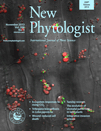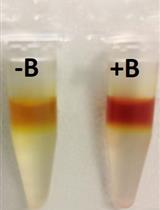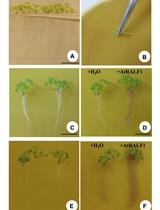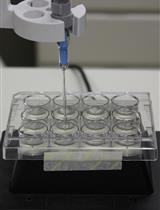- EN - English
- CN - 中文
An Assay to Test the Capacity of Arabidopsis Plant Defensin Type1 Protein to Induce Cellular Zinc (Zn) Tolerance in Yeast
拟南芥防御素1型蛋白诱导酵母细胞中锌耐受性的能力的测试分析
发布: 2015年11月20日第5卷第22期 DOI: 10.21769/BioProtoc.1653 浏览次数: 8557
Abstract
Heterologous expression of genes in budding yeast Saccharomyces cerevisiae (S. cerevisiae) is especially suitable to functionally study the corresponding encoded protein at the cellular level (Bonneaud et al., 1991). This is mainly because many strains defective in specific activities are available and could be complemented by homologous genes existing across the eukaryotic kingdom (http://www.yeastgenome.org/). However, the protocol we describe here is not a complementation but a “gain-of-function” assay. It is based on a drop-test assay that we have set up to assess the cellular zinc tolerance conferred by the expression of heterologous genes in the wild-type S. cerevisiae. Different dilutions of a yeast culture expressing the heterologous gene of interest are grown on a range of zinc-enriched plates, and are then compared to the control yeast expressing the empty vector. Working with different concentrations of both yeast and zinc are essential to succeed in describing zinc tolerance phenotype upon yeast transformation (Mirouze et al., 2006). This test has also proven to be valuable to differentiate among related members of gene families as exemplified for Arabidopsis Plant Defensin type1 (Shahzad et al., 2013).
Materials and Reagents
- Plastic foil (Saran Wrap)
- Sterile square 12 cm x 12 cm Petri dishes (CML HealthCare, catalog number: BP 120SJ )
- Sterile-R Filtropur S (0.2 µm) (SARSTEDT AG, catalog number: 83.1826.001 )
- 20 ml sterile syringe without needle (Medline Scientific, catalog number: BS-20ES )
- 50 ml sterile tubes (SARSTEDT AG, catalog number: 62.547.254 )
- Autoclaved 1.5 ml Eppendorf tubes (SARSTEDT AG, catalog number: 72.690 )
- Sterile inoculating loops (Greiner Bio One International GmbH, catalog number: 731175 )
- Sterile pipet tips
- Parental BY4741 S. cerevisiae strain (Winston et al., 1995; Brachmann et al., 1998) having the genotypes MATa, his3∆1, leu2∆0, met15∆0, ura3∆0) expressing: the pFL38H vector (Bonneaud et al., 1991), complementing the his3∆1 auxotrophy
- Transformed BY4741 yeast harbouring both: the pFL38H vector, complementing the his3∆1 auxotrophy and the pYX212 vector (Ingenius, R&D systems) complementing the ura3∆0 mutation and expressing the entire coding sequences of Arabidopsis PDF1s, i.e., including the signal peptide (Shahzad et al., 2013)
- Yeast nitrogen base (YNB) without amino acids and without ammonium sulfate (BD, Difco, catalog number: 233520 )
- Ammonium nitrate (NH4NO3) (Sigma-Aldrich, catalog number: A9642 )
- D(+)Glucose anhydrous (C6H12O6) (EUROMEDEX, catalog number: UG3050 )
- Succinic acid (C4H6O4) (Sigma-Aldrich, catalog number: S7501 )
- Potassium hydroxide (KOH) (Bio Basic Canada Inc., catalog number: PB0441 )
- Agarose type D-5 (EUROMEDEX, catalog number: D5 )
- Zinc sulphate heptahydrate (ZnSO4.7H2O) (Sigma-Aldrich, catalog number: Z4750 )
- L-leucine (C6H13NO2) (Sigma-Aldrich, catalog number: L8912 )
- L-methionine (C5H11NO2S) (Sigma-Aldrich, catalog number: M9625 )
- Sterile ultra-pure water
- 0.5 M zinc sulfate
- 10 N KOH (see Recipes)
- 0.075 M L-leucine (see Recipes)
- 0.1 M L-methionine (see Recipes)
- Sterile liquid and solid selective yeast nitrogen base (YNB) media (see Recipes)
Equipment
- Sterile 250 ml borosilicate glass Erlen flask
- 1,000 ml bottle
- Typical 20 µl pipet
- Autoclave
- Heating oven (Universal Memmert, model: 400 )
- New BrunswickTM Agitator (Eppendorf, model: Innova 44 )
- A normal cell density meter (Thermo Fisher Scientific, model: 40 )
- Laminar flow hood (ADS, model: VP120 )
- Centrifuge (Eppendorf, model: 5804R )
- Integral water purification system (Merck Millipore Corporation, model: Milli-Q+ )
- Scanner (Epson, model: 124OU )
Procedure
文章信息
版权信息
© 2015 The Authors; exclusive licensee Bio-protocol LLC.
如何引用
Shahzad, Z., Marquès, L., Berthomieu, P. and Gosti, F. (2015). An Assay to Test the Capacity of Arabidopsis Plant Defensin Type1 Protein to Induce Cellular Zinc (Zn) Tolerance in Yeast. Bio-protocol 5(22): e1653. DOI: 10.21769/BioProtoc.1653.
分类
微生物学 > 异源表达系统 > 酿酒酵母
植物科学 > 植物生理学 > 离子分析
细胞生物学 > 基于细胞的分析方法 > 离子分析 > 锌
您对这篇实验方法有问题吗?
在此处发布您的问题,我们将邀请本文作者来回答。同时,我们会将您的问题发布到Bio-protocol Exchange,以便寻求社区成员的帮助。
提问指南
+ 问题描述
写下详细的问题描述,包括所有有助于他人回答您问题的信息(例如实验过程、条件和相关图像等)。
Share
Bluesky
X
Copy link












